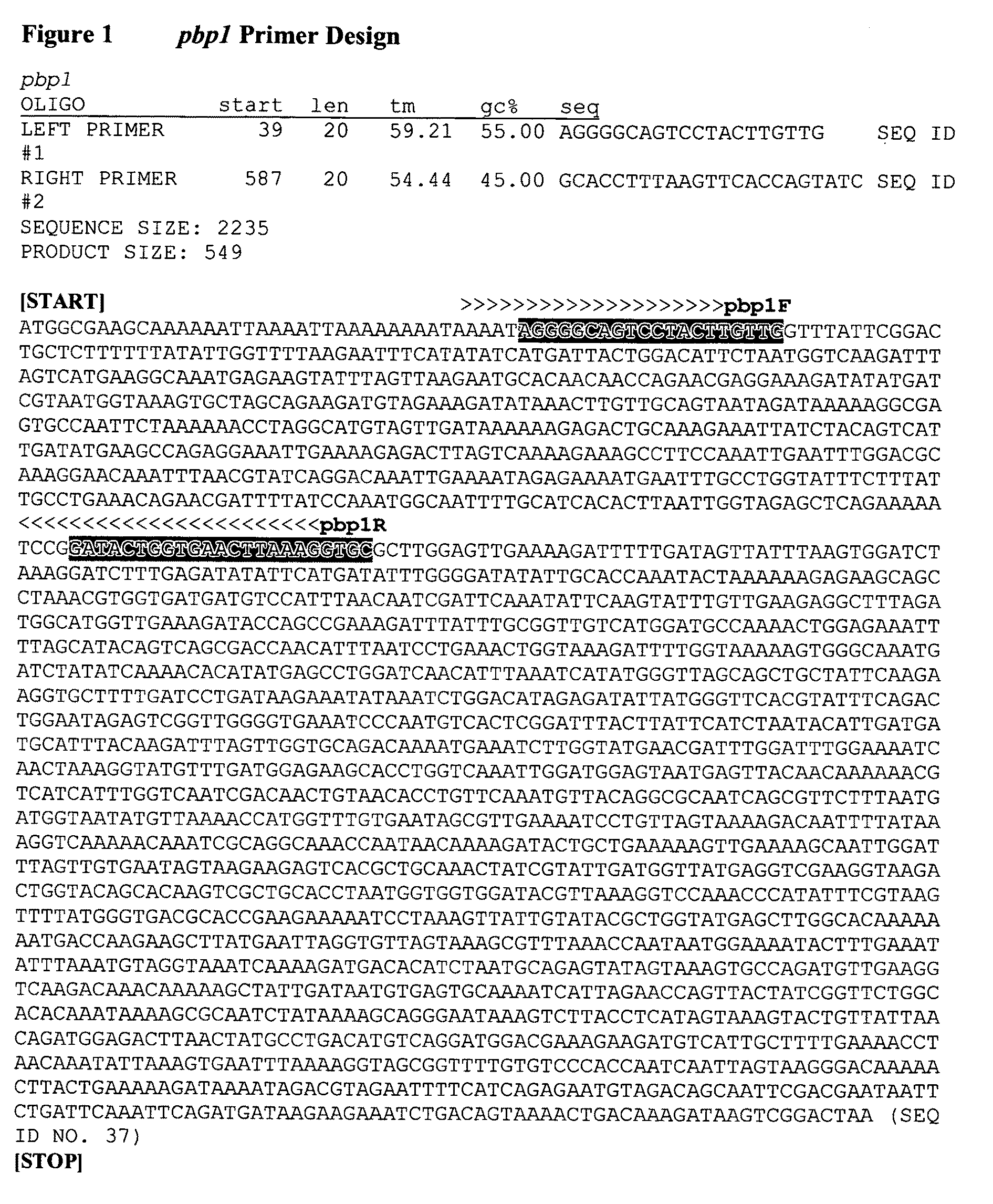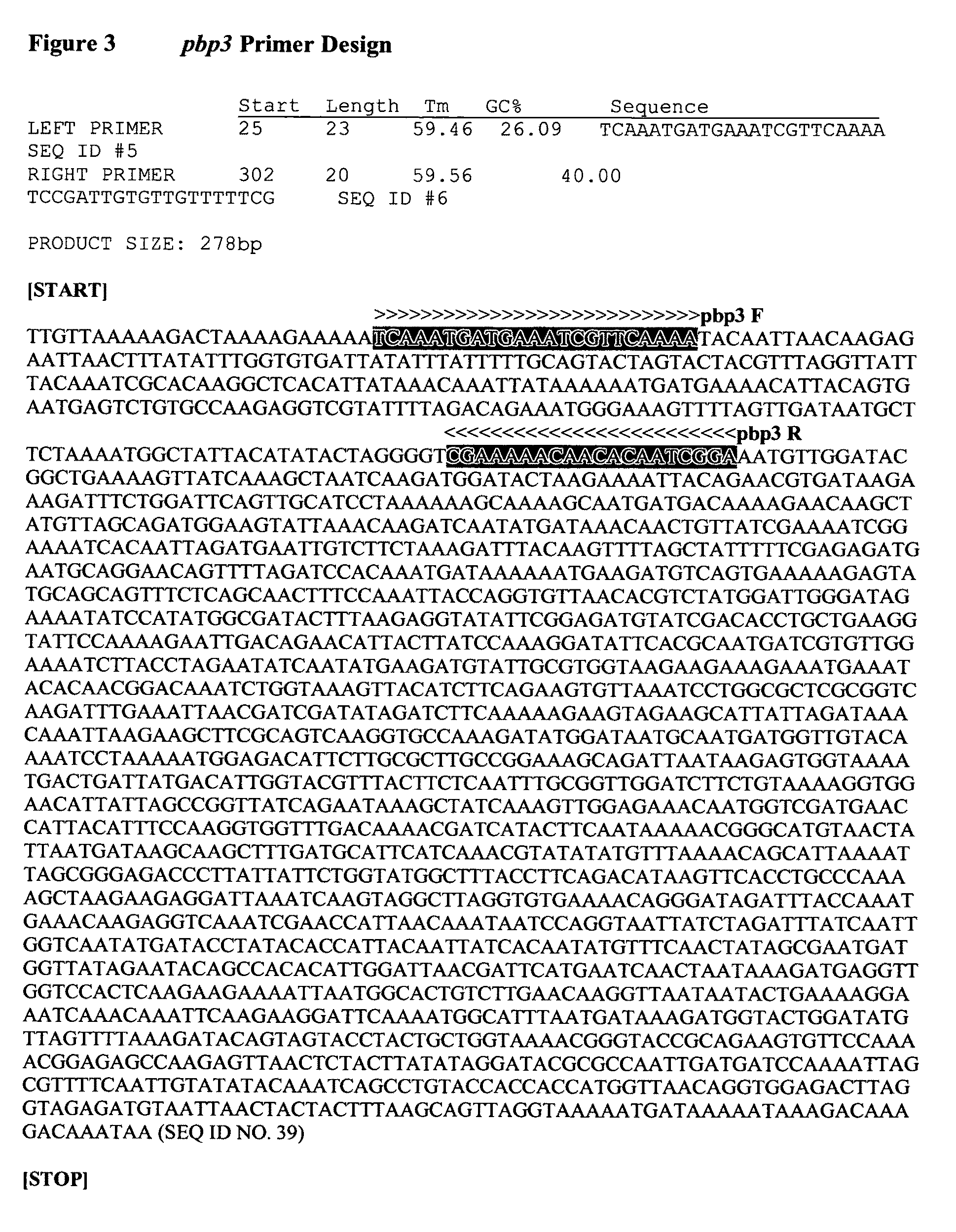Novel single nucleotide polymorphisms and community-associated methicillin-resistant staphylococcus aureus
a technology of methicillin-resistant staphylococcus and single nucleotide polymorphisms, which is applied in the field of diagnostics of infection with grampositive bacteria in mammals, can solve the problems of poor detection accuracy, high risk of i>staphylococcus aureus /i>infection, and limited choice of effective antibiotics
- Summary
- Abstract
- Description
- Claims
- Application Information
AI Technical Summary
Benefits of technology
Problems solved by technology
Method used
Image
Examples
example 1
Sequencing of Penicillin Binding Proteins (pbp 1-4) in Staphylococcus aureus
[0097]a) Sequencing of PBP 1-4
[0098]In 2009, Contreras-Martel et al. described single nucleotide polymorphisms (SNPs) located in the N-terminus of a Streptococcus pneumoniae penicillin binding protein (pbp) gene ultimately leading to decreased susceptibility to beta-lactam antibiotics. Therefore, we focused on sequencing portions of the N-termini of the four (4) penicillin binding proteins (pbps) (i.e., pbp1, pbp2, pbp3 and pbp4) in Staphylococcus aureus. We designed the primer sets (See, FIGS. 1-4) to amplify approximately 500 base pairs of the N-termini of these four (4) pbps.
[0099]We chose several representative laboratory strains of MSSA, CA-MRSA, and HA-MRSA to amplify DNA for sequencing. To do so, we extracted the genomic DNA from these laboratory strains of Staphylococcus aureus by lysing these laboratory strains with an anionic detergent followed by precipitation with 2-propanol using the modified Q...
example 2
Single Nucleotide Polymorphisms (SNPs) in Staphylococcus aureus pbp3 Gene and Association with Methicillin-Resistant Staphylococcus aureus
[0104]We sought to examine the validity of the G88A SNP of the pbp 3 gene as a molecular biomarker for detecting community-associated methicillin-resistant Staphylococcus aureus (CA-MRSA). To accomplish this, we obtained and phenotypically classified a large number of clinically isolated strains.
[0105]A) Clinical Samples—Determination of Infections with MRSA, CA-MRSA, HA-MRSA or MSSA
[0106]i) Patient Study
[0107]In the initial experiments, we obtained biological samples from forty-seven (47) patients suspected of infections caused by different types of Staphylococcus aureus; namely: (i) MRSA, (ii) community-associated MRSA (CA-MRSA), (iii) hospital-associated MRSA (HA-MRSA) or (iv) methicillin-susceptible Staphylococcus aureus (MSSA).
[0108]The gender and age information of these patients are summarized in Table 4. The provided patient information i...
example 3
Nucleotide Sequence Alignment of Publicly Available Staphylococcus aureus pbp3 Sequences from NCBI
[0121]A) Representative Laboratory Strains
[0122]To further confirm our findings in the clinical samples, we chose to examine representative Staphylococcus aureus laboratory strain types; namely, Hospital-Associated MRSA (HA-MRSA), Community-Associated MRSA (CA-MRSA), and methicillin susceptible S. aureus (MSSA) laboratory strain types. Publicly available amino acid and nucleotide sequences for representative strains (COL=HA-MRSA, Accession: NC—002951.2; USA300=CA-MRSA, Accessions: NC—007793.1 and NC—010079.1; MSSA476=MSSA, Accession: NC—002953.3) were aligned using the National Center for Biotechnology Information (NCBI) BLAST program.
[0123]In this sequence analysis, we aligned amino acid sequences of the penicillin binding protein 3 (pbp3). Through the amino acid alignment, two (2) amino acid changes of interest, V30I and D683N, were identified (See, FIG. 14). Both amino acid changes w...
PUM
| Property | Measurement | Unit |
|---|---|---|
| TM | aaaaa | aaaaa |
| temperature | aaaaa | aaaaa |
| temperature | aaaaa | aaaaa |
Abstract
Description
Claims
Application Information
 Login to View More
Login to View More - R&D
- Intellectual Property
- Life Sciences
- Materials
- Tech Scout
- Unparalleled Data Quality
- Higher Quality Content
- 60% Fewer Hallucinations
Browse by: Latest US Patents, China's latest patents, Technical Efficacy Thesaurus, Application Domain, Technology Topic, Popular Technical Reports.
© 2025 PatSnap. All rights reserved.Legal|Privacy policy|Modern Slavery Act Transparency Statement|Sitemap|About US| Contact US: help@patsnap.com



